MARIANI’S
March
25, 2007
NEWSLETTER

Nancy Walker as Rosie the
Waitress on the cover of Esquire
Magazine (November 1974)
WEBSITE: To
go to my web site, in which I will update food
&
travel information and help link readers to other first-rate travel
& food sites, click on: home page
ARCHIVE: Readers may now access
an
Archive of all past newsletters--each annotated--dating back to July,
2003, by simply clicking on www.johnmariani.com/archive
SUBSCRIBE AND
UN-SUBSCRIBE: You may subscribe anyone you wish
to this newsletter--free of charge--by
clicking here.
In
This Issue
NEW YORK CORNER: Café Cluny by John Mariani
NOTES FROM THE WINE CELLAR: Kendall Jackson Shows Lots to Love by Mort Hochstein
QUICK BYTES
GRINDING IT OUT IN THE GREAT WORLD OF COLD CUTS
by John Mariani

Any way you slice it, the hottest restaurant trend right now is salami. And French charcuterie. And Spanish chorizo. Maybe even baloney.
The fact is, some of the best chefs and restaurateurs in America have turned their attention to the one thing few have ever attempted before: Making their own sausages or paying to have it made to their specs. And they’re serving them up in small, boisterous restaurants where eating with your fingers and sharing a platter with your friends is the way to go. You get a bottle of cheap but good wine, maybe a Syrah from the Rhône, a Rioja from Spain, or a Barbera from Italy, and you need nothing else to be as happy a the proverial pig in a sty.
Not very long ago, the only charcuterie (a French term derived from the words chair, “flesh,” and cuit, “cooked”) you would find in a States-side French restaurant was a pâté maison or perhaps some dry sausage called saucisson chaud, almost never made in house. Italian restaurants always offered prosciutto and maybe some Genoa salami (both domestic), and of course German restaurants have always served wursts.

But now, very well-known American chefs have turned not just their attentions but their kitchens to making an amazing variety of charcuterie, from dry sausages like chorizo to fresh sausages that need to be cooked like Italian cotechino. One of the earliest to start making his own charcuterie—and this was only five years ago—was Mario Batali, whose great-grandfather made salami upon moving to Seattle in 1903 and whose father still runs an Italian deli there named Salumi. Mario, who made his fame with the fine dining Italian restaurant Babbo, and partner Joe Bastianich, opened a Greenwich Village osteria called Lupa, where the featured item is a wooden platter of Italian cold cuts, which were a big hit.
They followed this success two years ago with a small tapas bar named Casa Mono and, right next door, Bar Jamon, with only 14-stools, where they serve two of the most esteemed Spanish hams, Navidul and Redondo. Now, at their newest, Del Posto, they have succeeded in making some very fine cotechino, which they serve with the traditional lentils.
Charcuterie has always fascinated American chefs, but I think they’ve been a little queasy about making the stuff themselves, health regulations being what they are about cured, preserved meats. But several have overcome their fears and launched into production with their usual American passion of discovery.
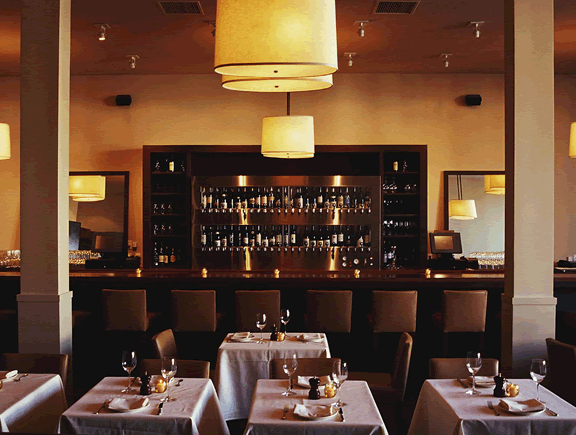 Los Angeles restaurateurs Suzanne Goin
and Caroline Styne opened A.O.C.
(left),
the abbreviation for
the
French
food law term appellation d’origine controlée, which
guarantees the
authenticity of a regional food or wine. Here,
in a loud, two-story restaurant with a
big bar crowd that comes not for the drinks but for the charcuterie,
the two women
feature platters to be shared of Italian coppa,
prosciutto, and soppressata, Serrano ham, foie gras
terrine, pork
rillettes, and
dishes like clams with chorizo sausage and chickpeas.
Los Angeles restaurateurs Suzanne Goin
and Caroline Styne opened A.O.C.
(left),
the abbreviation for
the
French
food law term appellation d’origine controlée, which
guarantees the
authenticity of a regional food or wine. Here,
in a loud, two-story restaurant with a
big bar crowd that comes not for the drinks but for the charcuterie,
the two women
feature platters to be shared of Italian coppa,
prosciutto, and soppressata, Serrano ham, foie gras
terrine, pork
rillettes, and
dishes like clams with chorizo sausage and chickpeas.In Chicago, chef-restaurateur Paul Kahan, whose restaurant Blackbird is one of the city’s hottest, opened a slender, little, wood-panelled eatery right next door called Avec, where chef Koren Grieveson has devoted herself to learning all the mysteries and techniques of charcuterie. Her long menu teems with little plates of freshly made salumi and shaved Serrano ham with persimmon, queso fresca, olive oil and mint. The wine list of Mediterranean bottlings is chosen to go well with this kind of food and is priced accordingly.
In Seattle, Chef John Sundstrum at Lark restaurant (below) features at least seven charcuterie items each night, including chorizo with prunes, cold poached beef tongue with a creamy horseradish, foie gras terrine, and German Landjaeger salami with two mustards. There’s also a communal table in the center that can turn strangers into friends and advisors.
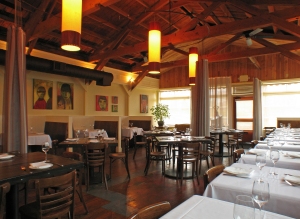
This is gutsy stuff. For while highly refined charcuterie like terrine of foie gras with truffles might make it onto an haute cuisine menu, charcuterie has always been associated with the low end of gastronomy. Indeed, most of the meat ground up to make charcuterie is from the low ends of the animal, usually pig. Because of the cuts used, charcuterie has, largely, been considered ethnic food, and its ancient history is based on people’s need to preserve as much food as possible by utilizing every part of the animal and then curing it so as to render it safe and edible throughout the year.
France’s Larousse Gastronomique lists only some of the numerous preparations that go under the name charcuterie, including cured meats, fresh and dried sausages, pâtés, smoked andouilles, blood sausage, white veal sausage, hams, and galantines (a forcemeat cooked and made into a shape, sometimes with aspic). For most of French gastronomic history such lowly items would never appear at royal banquets or on high-class dinner tables, though this began to change at the end of the 19th century when a pork butcher named Louis-François Drone published a monumental volume on charcuterie that demonstrated the artisan quality of such foods. The genre’s prestige was further heightened when, on December 9, 1893, Le Figaro published an all-charcuterie menu by one of the era’s great chefs, Gustave Carlin.
Nevertheless, except for lavishly decorated pâtés and terrines, charcuterie remained a specialty item rarely served at posh restaurants and available only at specialty, usually ethnic, butcher shops. Living in a suburb of Manhattan, I am lucky to be within an hour's drive of excellent German, Italian, Polish, Hungarian, Spanish, and Chinese butchers, whose range of sausages, head cheese, and salamis is daunting. One of my favorites is Biancardi’s, an old Italian butcher shop in the Bronx, where they make their own cotechino, a fresh pork sausage originated in Modena. It must be boiled quite a long time to achieve the ideal texture, which is slightly crumbly. It is
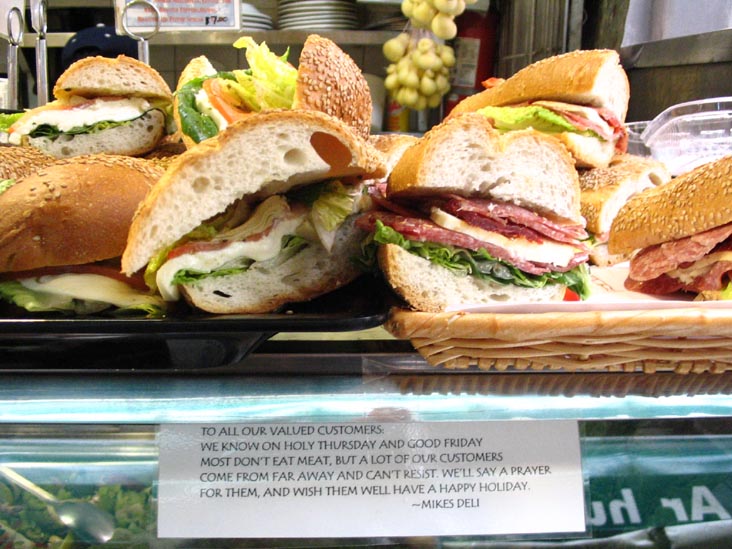 shot
through with spices, and, served with lentils and carrots drizzled with
balsamic vinegar, it is one of the heartiest, most delicious dishes I
know.
shot
through with spices, and, served with lentils and carrots drizzled with
balsamic vinegar, it is one of the heartiest, most delicious dishes I
know.In Modena they make cotechino in galera (“cotechino in prison”), which is a half-cooked cotechino wrapped in slices of prosciutto and beef, then cooked further in an earthenware dish with onions, consommé and white Lambrusco wine. Also in the same neighborhood is Mike's Deli, which has an enormous array of sausages, salumi, prosciutti, and much else that they pile on huge hero sandwiches (left).
O ne can make charcuterie at home if you have the right climatic conditions, meaning a cold storage room (which could mean a drafty New England or Michigan attic) and a familiarity with curing salts like sodium nitrate. Raw and hot-smoked sausages, which are consumed quickly, do not have a need for either cold or salts, so it’s easier, if a little messy, to make such sausages at home. (For those who want to try it, the best book on the subject is Hot Links and Country Flavor: Sausages in American Cooking by Bruce Aidells and Denis Kelly.)
One might well ask why we can’t buy imported charcuterie from France, Italy, Spain, and other countries that have been perfecting it for centuries. The answer lies in the restrictive Department of Agriculture protectionist laws, urged on by the U.S. pork producers, to keep as much pork product out of the U.S. as possible. For decades Italian prosciutto was banned, on the pretense that a leg of the ham might contain hoof-and-mouth disease (harmless to humans but affecting animals) or trichinosis (a parasitic infestation now extremely rare in the U.S. and almost always the effect of eating wild game).
A few years ago Prosciutto di Parma (below), a registered trademark name for a specific ham produced in the region around Parma, did gain access to the U.S., but other prosciutto producers have had a tough time of it. Neither will you find much Spanish ham imported for the same reason, and it is why only boiled, canned Polish hams may enter the country, but not fresh ones.
This is fine for American pork producers and for those ethnic butchers and restaurateurs who make their own charcuterie. And to tell the truth, American charcuterie gets better every year, especially now that a generation of passionate American chefs has turned its attention to charcuterie and are trying to replicate the taste of the European originals.
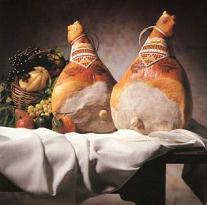
Yet there are some sausages and hams I still crave but cannot get in the U.S. unless a facsimile is made here. Italy’s cured pork jowl, called guanciale, the classic addition to Rome’s spaghetti alla carbonara, is much better over there than the few domestic guanciales I’ve had here. And I have never, ever, tasted anything as sweet, nutty, and buttery as the Spanish ham called jamòn ibérico (not Serrano ham) produced in very small quantities by Joselito, a company near Salamanca. It is a beautiful ham, silky and pink, not briney-tasting or salty. And it is very very expensive.
But because the USDA has determined that (at least not yet) Joselito’s slaughterhouses do not conform to American standards, Joselito does not come to the U.S. There is much politics in all these regulations, and it’s a shame. But as long as young Americans are on the job, it may be sooner rather than later when we have charcuterie every bit as good as that from abroad.
Charcuterie—French general term for all sausages, pâtés, rillettes, and terrines.
Rillettes—French mashed or ground meats or fish preserved in small pots, usually served with cornichons.
Terrine—Coarsely ground meats baked in an earthenware mold and served in slabs.
Pâté—Basically a terrine baked in a pastry crust.
Saucisson—French term for sausages.
Boudin noirs—Blood sausage
Tête de veau—Head cheese, made from ground pig’s head and seasonings.
Wurst—General German term for sausages.
Serrano ham—Cured Spanish ham from pigs that feed on acorns.
Morcilla—Spanish black pudding sausage.
Chouriço—General Spanish term for sausages. The best known is linguiça made from ground pork.
Salumi—General Italian term for all cured meats like Prosciutto, and includes salami.
Salami—General Italian term for salami, which derives from the Latin, sal, “salt,” used to cure it. There are three basic types, fresh, dry aged, and pre-cooked.
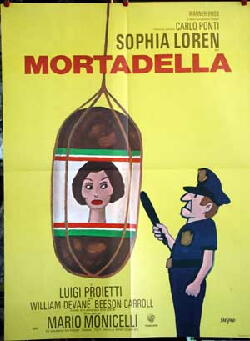
Prosciutto—Air-dried ham, the best from Parma.
Salsicce—Italian term for sausage.
Culatello—Cured pork rump cut from the bone. The word means “little ass.”
Coppa—Italian cooked and pressed cured boneless pork neck that is brined and stuffed into a casing, then air dried.
Soppressata—Salame made from pork meat and fat flavored with lemon peel and spices.
Mortadella—Italian finely ground pork sausage from Bologna, usually flavored with peppercorns.
NEW YORK CORNER
by John Mariani
Photo by Galina Stepanoff-Dargery
Cafe Cluny
284 W. 12th Street
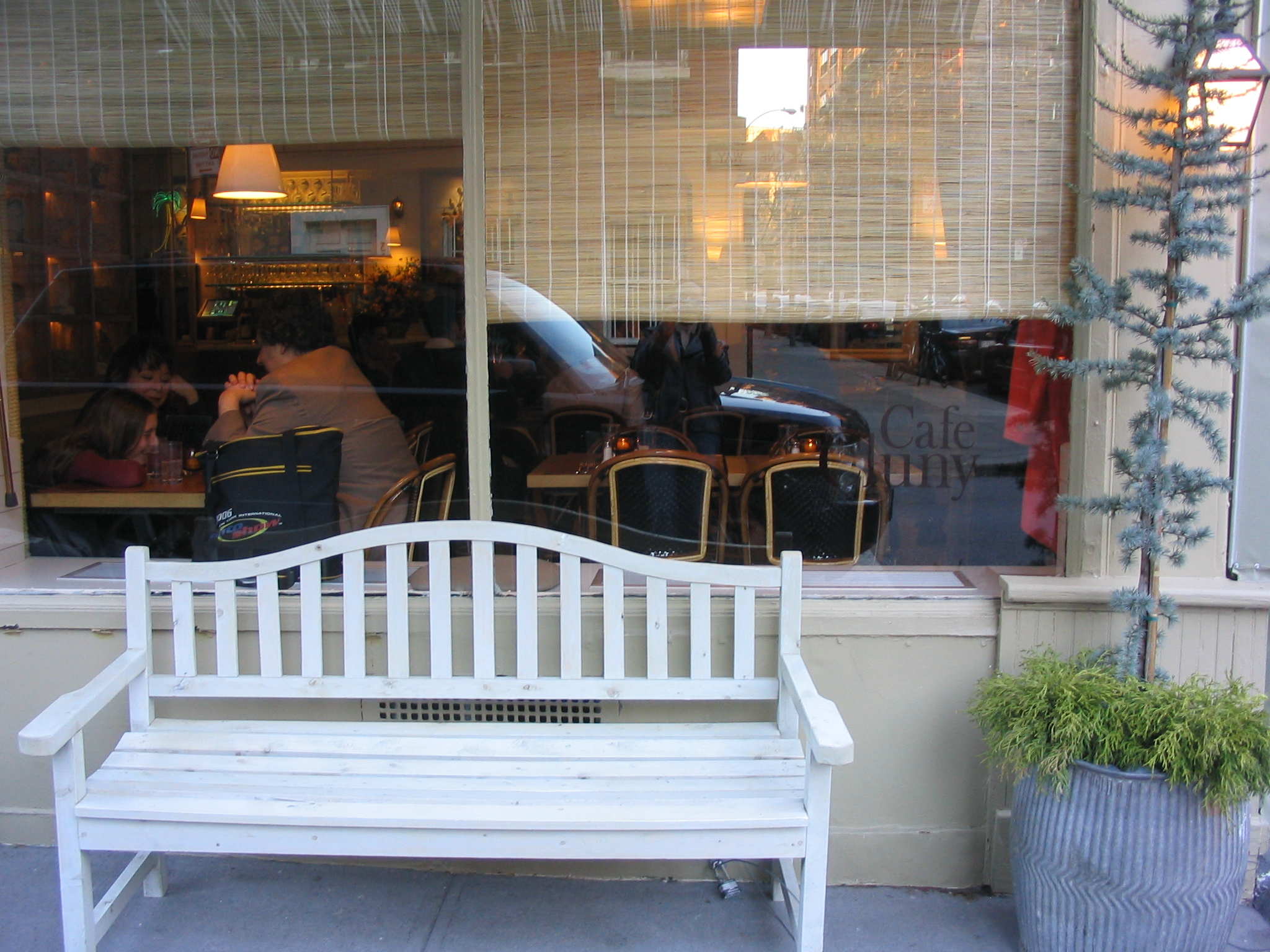
212-255-6900
The one-page menu (right), on the back of which is printed the 21-selection winelist (ranging from $28 to $66 a bottle), has
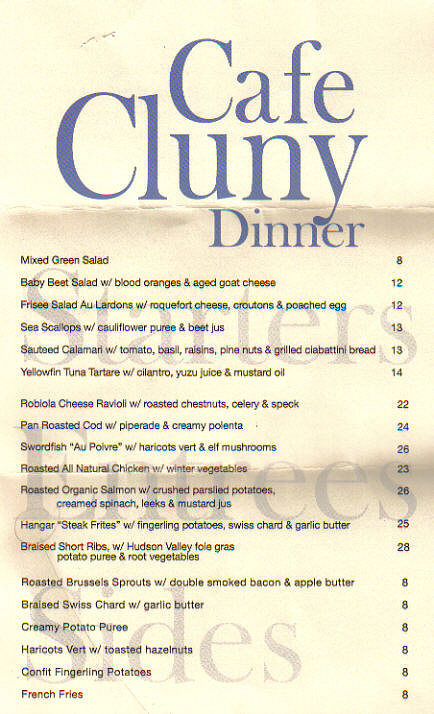 little on it that a thousand other
restaurants
don't,
including both The Odeon and Café Luxembourg (My God, the cooks
must get
bored!), and if this is supposed to be a facsimile of a French
bistro
menu, it fails by including but a few clichés and nothing out of
the
ordinary--no charcuterie, no casseroles, no array of cheeses, and only
the
dullest of desserts. It's one of those menus that makes you scratch
your
head as
to what to order because nothing much stirs the appetizer. Mixed green
salad? Nope. Tuna tartare? Ho-hum. Roast salmon with
creamed
spinach? Nnnnn-no. Well, we had to eat something, so we ordered a
frisée salad
with lardons, very salty Roquefort cheese, croutons, and a poached egg,
which was
standard issue. Sea scallops with a cauliflower purée and
beet
jus was
boring, and sautéed--not fried--calamari were flaccid and
flavorless,
despite
accompanying tomato, basil, raisins, pin nuts, and grilled bread.
Gnocchi with
chopped up mushrooms did little to ring anyone's chimes.
little on it that a thousand other
restaurants
don't,
including both The Odeon and Café Luxembourg (My God, the cooks
must get
bored!), and if this is supposed to be a facsimile of a French
bistro
menu, it fails by including but a few clichés and nothing out of
the
ordinary--no charcuterie, no casseroles, no array of cheeses, and only
the
dullest of desserts. It's one of those menus that makes you scratch
your
head as
to what to order because nothing much stirs the appetizer. Mixed green
salad? Nope. Tuna tartare? Ho-hum. Roast salmon with
creamed
spinach? Nnnnn-no. Well, we had to eat something, so we ordered a
frisée salad
with lardons, very salty Roquefort cheese, croutons, and a poached egg,
which was
standard issue. Sea scallops with a cauliflower purée and
beet
jus was
boring, and sautéed--not fried--calamari were flaccid and
flavorless,
despite
accompanying tomato, basil, raisins, pin nuts, and grilled bread.
Gnocchi with
chopped up mushrooms did little to ring anyone's chimes.Entrees continued along the same lines: Pan-roasted cod with a dreary piperade and polenta didn't click, and though juicy, a roasted chicken with winter vegetables wasn't much better than I might get at a diner. I'm getting a tad tired of seeing shortribs on every menu, unless they are really special: Cafe Cluny's were not. And a "hangar [sic] steak" came with fingerling potatoes so limp as to be inedible. The meat itself was properly chewy and flavorful, however.
As you can imagine, dessert held no surprises: Profiteroles came encased in a pastry as tough as cardboard, and although I loved the first spoonful of chocolate pudding--an rather childlike rendering--I soon tired of its gluey consistency and cloying sweetness.
So the bottom line is, if you wanna be someone who needs to be seen at a Wagenecht restaurant, head for Cafe Cluny--once. Indeed, a meal this mediocre makes me think I should go back to her other restaurants to see how they're holding up in quality.
NOTES FROM THE WINE CELLAR
Kendall Jackson Shows Lots to Love
by Mort Hochstein
The first time I tasted a Kendall Jackson Vintners Reserve Chardonnay, I was so impressed that I called Jess Stonestreet Jackson to express my feelings directly. That was a couple of decades ago. I doubt that I would be able to reach him so easily these days, since that wine has become the foundation for an empire of fine wines.
KJ, as the label is popularly known, is now a huge seller, particularly on restaurant lists. There have always been questions among purists who question its residual sugar content and the use of "reserve" as a name for the basic wine of the KJ list, since that term is usually associated with a winery's top-of-the-line wine product. KJ starts off with Vintners Reserve at the base of a pyramid that steps up to Grand Reserve, then to Highland Estates and peaks with the Stature line.
Kendall Jackson, or the formal name, Jackson Family Wines, is now an empire, bottling some five million cases annually from its own and contracted vineyards in Napa, Sonoma, Monterey and Santa Barbara , with three dozen brands, including wineries in Italy, France, Chile and Australia, often among the best in their class. Many were well established before being absorbed into the KJ fold, but operate as semi-independent fiefdoms and, from what I’ve seen, there is very little micromanaging from the top.
That empire encompasses four division, Kendall-Jackson Wine Estates, Rocket Brands, Artisan & Estates, and Jackson Wine Estates International. Wineries under the banner of Artisan & Estates include well-established names such as Byron, Edmeades,
Hartford Family Wines, nestled in rolling green hills near
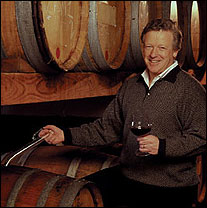 On
a recent visit, I sampled wines
with founder Don Hartford (left). Hartford
Court makes a pair of single-vineyard Chardonnays, each expressing a
different
Sonoma coast terroir, and one blended
white, Four Hearts Vineyards Russian
River Valley
Chardonnay. The goal, Hartford says, is to identify individual vineyards with a potential for great growth and quality
equivalent to the best of
On
a recent visit, I sampled wines
with founder Don Hartford (left). Hartford
Court makes a pair of single-vineyard Chardonnays, each expressing a
different
Sonoma coast terroir, and one blended
white, Four Hearts Vineyards Russian
River Valley
Chardonnay. The goal, Hartford says, is to identify individual vineyards with a potential for great growth and quality
equivalent to the best of Grapes for Four Hearts, a blend initiated with the 2005 vintage, come from the family estate and neighboring vineyards and from a variety of clones that are picked and barrel fermented separately before blending. The ‘05 comes across with an outgoing nose rich in white peach and citrus scents, pear and sweet lemon on the palate and a long, spice-loaded finish. It’s an elegant white, good now, and it should be even better with about two years more in bottle, and, since it is produced in relatively large amounts, about 6,000 cases, more readily available than the single vineyard wines.
The 2005 vintage was a gift for growers in the Russian River Valley, a year of average quantity, with even temperatures right through harvest yielding ripe, deeply flavored grapes. Stone Cote ’05, one of Hartford’s two single-vineyard Chardonnays, is ripe with rich aroma of orange blossom, rich hazelnut, peach and lemon candy flavors and strong but balanced acidity and minerality, peach and stone-fruit flavors, and long, lingering tones of apricot on the finish, The wine was not fined or filtered. Only 900 cases were made.
The grapes come from cold climate vineyards with a limited but concentrated yield and picking can go on into November. The Annapolis Vineyard, principal source for Land’s Edge, is two hours away from the winery. It and neighboring fields are the basis for a wine that, though still slightly shy at our tasting, shows ripe cherries and violets on the nose, black cherry and black berries mixed with allspice and coffee flavors on the palate and a pleasingly long finish.
Due South from Fort Ross, near Bodega Bay also about two hours from home base, is the source for Seascape Vineyard, one of the eight single vineyard Pinot Noirs produced under the Hartford Court mark. “This is a true example of our high-risk, high-reward concept,”
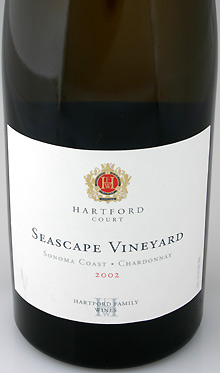
Arrendell Vineyard Pinot Noir, the most expensive in the line at $75, comes from fields a short hike from the winery near
We tasted the ’04 Russian River Valley Zinfandel, whose grapes come from ancient vineyards, averaging about 75 years of age. That limited fruit output transforms into wine with neutral acidity and bright fruit aromas and flavors. The ‘04 is deeply concentrated, with a swirl of spicy scents, including blackberry, black pepper and anise, and richly flavored with allspice, anise , and caramel.
While its limited production of single vineyard Chardonnay, Pinot Noir and Zinfandel usually disappear to the cellars of fans and collectors, the blends are more readily available. The 2005 vintage, says Jeff Mengahas, winemaker for
The Zin blend is $30, with single vineyard labels ranging upwards to $50. Chardonnay and Pinot Noir start at $40 and top out at $75 for the Pinot Noir and $60 for Chardonnay.
In price, and in quality, they are a far cry from the humble Vintners Reserve that I enjoyed back in the eighties, the brand that remains as is the foundation of the Kendall-Jackson family of wines. But Americans back then were just beginning to develop a taste for wine. The success of
WRETCHED EXCESS NO. 5,268
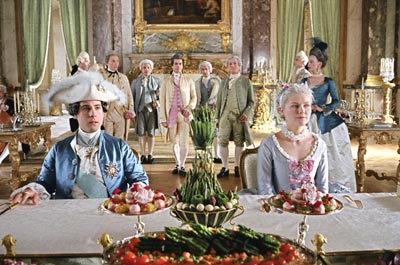
Hilton Arc de Triomphe is teaming up with one of
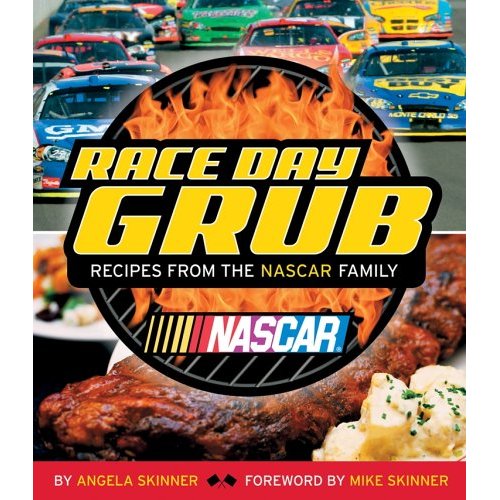 Eat
Here, Get
Gas
Eat
Here, Get
GasRecipes from the book Race Day Grub: Recipes from the NASCAR Family by Angela Skinner.
-Heart Attack on a Plate
-Mexican Crunch Mix
-Bacon Thingies
-"Manly" Nachos
-Salmon in Merlot
-Parked Salad
-Checkered Flag Corn on the Cob
-Lug-Nut Doughnuts
NEW FEATURE: I am happy to report that the Virtual Gourmet is linking up with two excellent travel sites:
QUICK BYTES
* The
* Montage
or www.casadesierranevada.com.
* At Little Palm Island Resort & Spa on Little Torch Key, FL, Starlight Social Chef's Table features its 5-course dinner series hosted by Chef Luis Pous and limited to 20 people. The next installation will be on April 12 and continues on the second Thurs. of every month. $100 pp, $150 with wine pairings. Call 305-872-2551.
* From April 13-15 in Manchester Village, VT, Executive Chef Andreas Hartmann of the Equinox will host guest chefs for a “Spring Celebration of Food and Wine” with its own competition with guests chefs as well as a “Farmers’ Market,” featuring a variety of New England-grown products.
* The Grace Bay Club in Providenciales, Turks & Caicos Islands, is offering the Family Package to families staying 5, 7,or 10 nights, incl: Free night; transfer to and from hotel; Lunch and Dinner a la carte' for four, five or seven days at 'The Grill'; Private Beach excursion, Snorkel and Conch Cruise; VIP Kids Club membership; Lunch at Da Conch Shack; more. Call 800-946-5757. Visit www.gracebayclub.com.
~~~~~~~~~~~~~~~~~~~~~~~~~~~~~~~~~~~~~~~~~~~~~~~~~~~~~~~~~~~~~~~~~~~~~~~~~
MARIANI'S VIRTUAL GOURMET NEWSLETTER is published weekly. Editor/Publisher:
John Mariani. Contributing Writers: Robert Mariani, Naomi
Kooker, Kirsten Skogerson, Edward Brivio, Mort
Hochstein, Suzanne Wright. Contributing
Photographers: Galina Stepanoff-Dargery, Bobby Pirillo. Technical
Advisor: Gerry McLoughlin.
Any of John Mariani's books below
may be ordered from amazon.com by clicking on the cover image.
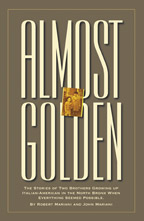 My
newest book, written with my brother Robert Mariani, is a memoir of our
years growing up in the My
newest book, written with my brother Robert Mariani, is a memoir of our
years growing up in the For those of you who don't think of the Robert and I think you'll enjoy this very personal look at our --John Mariani |
 |
 |
 |
 |
 |
 |
copyright John Mariani 2007

